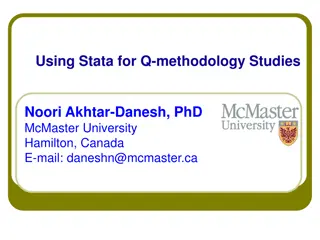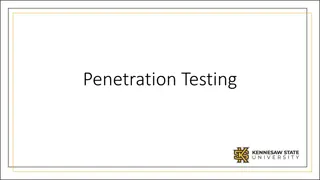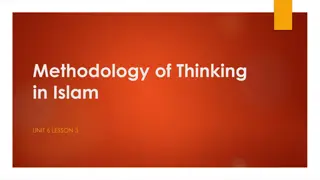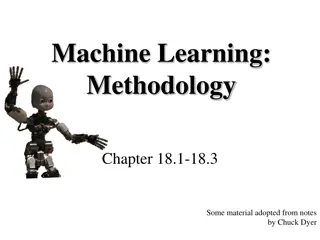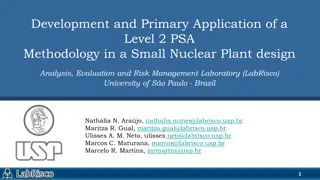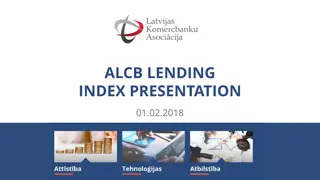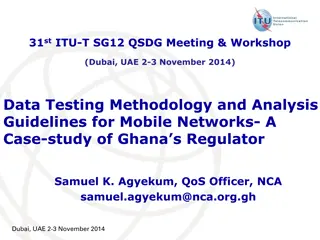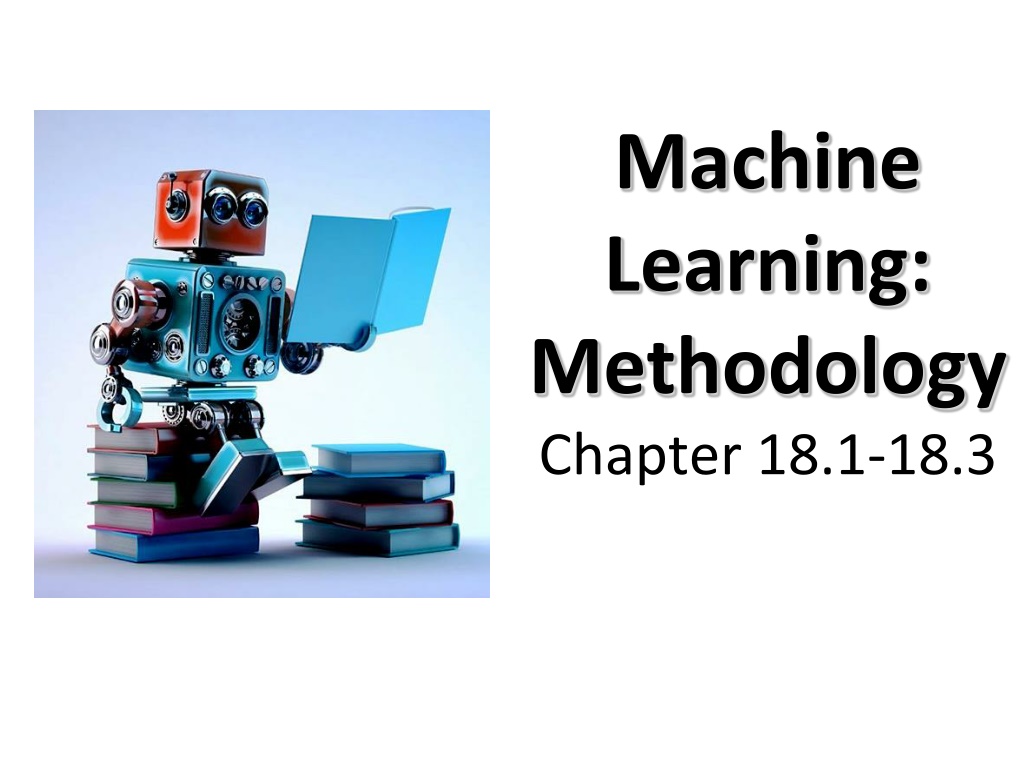
Machine Learning Methodology and Evaluation
In this content snippet, various aspects of machine learning methodology are discussed, including examples from the Zoo dataset and the application of a Decision Tree Learner. The evaluation methodology for measuring the performance of learning algorithms is also detailed, emphasizing the importance of collecting large datasets with correct classifications and keeping training and test sets disjoint for reliable results.
Download Presentation

Please find below an Image/Link to download the presentation.
The content on the website is provided AS IS for your information and personal use only. It may not be sold, licensed, or shared on other websites without obtaining consent from the author. If you encounter any issues during the download, it is possible that the publisher has removed the file from their server.
You are allowed to download the files provided on this website for personal or commercial use, subject to the condition that they are used lawfully. All files are the property of their respective owners.
The content on the website is provided AS IS for your information and personal use only. It may not be sold, licensed, or shared on other websites without obtaining consent from the author.
E N D
Presentation Transcript
Machine Learning: Methodology Chapter 18.1-18.3
http://archive.ics.uci.edu/ml 233 data sets
animal name: string hair: Boolean feathers: Boolean eggs: Boolean milk: Boolean airborne: Boolean aquatic: Boolean predator: Boolean toothed: Boolean backbone: Boolean breathes: Boolean venomous: Boolean fins: Boolean legs: {0,2,4,5,6,8} tail: Boolean domestic: Boolean catsize: Boolean type: {mammal, fish, bird, shellfish, insect, reptile, amphibian} Zoo data 101 examples aardvark,1,0,0,1,0,0,1,1,1,1,0,0,4,0,0,1,mammal antelope,1,0,0,1,0,0,0,1,1,1,0,0,4,1,0,1,mammal bass,0,0,1,0,0,1,1,1,1,0,0,1,0,1,0,0,fish bear,1,0,0,1,0,0,1,1,1,1,0,0,4,0,0,1,mammal boar,1,0,0,1,0,0,1,1,1,1,0,0,4,1,0,1,mammal buffalo,1,0,0,1,0,0,0,1,1,1,0,0,4,1,0,1,mammal calf,1,0,0,1,0,0,0,1,1,1,0,0,4,1,1,1,mammal carp,0,0,1,0,0,1,0,1,1,0,0,1,0,1,1,0,fish catfish,0,0,1,0,0,1,1,1,1,0,0,1,0,1,0,0,fish cavy,1,0,0,1,0,0,0,1,1,1,0,0,4,0,1,0,mammal cheetah,1,0,0,1,0,0,1,1,1,1,0,0,4,1,0,1,mammal chicken,0,1,1,0,1,0,0,0,1,1,0,0,2,1,1,0,bird chub,0,0,1,0,0,1,1,1,1,0,0,1,0,1,0,0,fish clam,0,0,1,0,0,0,1,0,0,0,0,0,0,0,0,0,shellfish crab,0,0,1,0,0,1,1,0,0,0,0,0,4,0,0,0,shellfish
Zoo example aima-python> python >>> from learning import * >>> zoo <DataSet(zoo): 101 examples, 18 attributes> >>> dt = DecisionTreeLearner() >>> dt.train(zoo) >>> dt.predict(['shark',0,0,1,0,0,1,1,1,1,0,0,1,0,1,0,0]) 'fish' >>> dt.predict(['shark',0,0,0,0,0,1,1,1,1,0,0,1,0,1,0,0]) 'mammal
Evaluation methodology (1) Standard methodology: 1. Collect large set of examples with correct classifications 2. Randomly divide collection into two disjoint sets: training and test 3. Apply learning algorithm to training set giving hypothesis H 4. Measure performance of H w.r.t. test set
Evaluation methodology (2) Important: keep the training and test sets disjoint! Study efficiency & robustness of algorithm: repeat steps 2-4 for different training sets & training set sizes On modifying algorithm, restart with step 1 to avoid evolving algorithm to work well on just this collection
Evaluation methodology (3) Common variation on methodology: 1. Collect large set of examples with correct classifications 2. Randomly divide collection into two disjoint sets: development and test, and further divide development into devtrain and devtest 3. Apply learning algorithm to devtrain set giving hypothesis H 4. Measure performance of H w.r.t. devtest set 5. Modify approach, repeat 3-4 as needed 6. Final test on test data
Zoo evaluation train_and_test(learner, data, start, end) uses data[start:end] for test and the rest for train >>> dtl = DecisionTreeLearner >>> train_and_test(dtl(), zoo, 0, 10) 1.0 >>> train_and_test(dtl(), zoo, 90, 100) 0.80000000000000004 >>> train_and_test(dtl(), zoo, 90, 101) 0.81818181818181823 >>> train_and_test(dtl(), zoo, 80, 90) 0.90000000000000002
K-fold Cross Validation Problem: getting ground truth data expensive Problem: Need different test data each time we test Problem: experiments needed to find right feature space & parameters for ML algorithm Goal: minimize training+test data needed Idea: split training data into K subsets, use K-1 for training, and one for development testing Common K values are 5 and 10
Zoo evaluation cross_validation(learner, data, K, N) does N iterations, each time randomly selecting 1/K data points for test, rest for train >>> cross_validation(dtl(), zoo, 10, 20) 0.95500000000000007 leave1out(learner, data) does len(data) trials, each using one element for test, rest for train >>> leave1out(dtl(), zoo) 0.97029702970297027
Learning curve Learning curve = % correct on test set as a function of training set size
Zoo >>> learningcurve(DecisionTreeLearner(), zoo) [(2, 1.0), (4, 1.0), (6, 0.98333333333333339), (8, 0.97499999999999998), (10, 0.94000000000000006), (12, 0.90833333333333321), (14, 0.98571428571428577), (16, 0.9375), (18, 0.94999999999999996), (20, 0.94499999999999995), (86, 0.78255813953488373), (88, 0.73636363636363644), (90, 0.70777777777777795)] 1.2 1 0.8 0.6 0.4 0.2 0 1 3 5 7 9 11 13 15 17 19 21 23 25 27 29 31 33 35 37 39 41 43
Iris Data Three classes: Iris Setosa, Iris Versicolour, Iris Virginica Four features: sepal length and width, petal length and width 150 data elements (50 of each) aima-python> more data/iris.csv 5.1,3.5,1.4,0.2,setosa 4.9,3.0,1.4,0.2,setosa 4.7,3.2,1.3,0.2,setosa 4.6,3.1,1.5,0.2,setosa 5.0,3.6,1.4,0.2,setosa http://code.google.com/p/aima-data/source/browse/trunk/iris.csv
Comparing ML Approaches The effectiveness of ML algorithms varies de- pending on the problem, data and features used You may have intuitions, but run experiments Average accuracy (% correct) is a standard metric >>> compare([DecisionTreeLearner, NaiveBayesLearner, NearestNeighborLearner], datasets=[iris, zoo], k=10, trials=5) iris zoo DecisionTree 0.86 0.94 NaiveBayes 0.92 0.92 NearestNeighbor 0.85 0.96
Confusion Matrix (1) A confusion matrix can be a better way to show results For binary classifiers it s simple and is related to type I and type II errors (i.e., false positives and false negatives) There may be different costs for each kind of error So we need to understand their frequencies predicted a/c C ~C True positive False negative actual C False positive True negative ~C
Confusion Matrix (2) For multi-way classifiers, a confusion matrix is even more useful It lets you focus in on where the errors are predicted Cat Dog rabbit Cat 5 3 0 actual Dog Rabbit 2 0 3 2 1 11
Accuracy, Error Rate, Sensitivity, Specificity A\P C C Class Imbalance Problem: C TP FN P One class may be rare, e.g. fraud, HIV-positive, ebola C FP TN N P N All Significant majority of the negative class and minority of the positive class Classifier Accuracy, or recogni- tion rate: percentage of test set tuples that are correctly classified Accuracy = (TP + TN)/All Error rate:1 accuracy, or Error rate = (FP + FN)/All Sensitivity: True Positive recognition rate Sensitivity = TP/P Specificity: True Negative recognition rate Specificity = TN/N
On Sensitivity and Specificity sensitivity measures avoiding of false negatives specificity measures avoiding false positives TSA security scenario: metal scanners set for low specificity (e.g., trigger on keys) to reduce risk of missing dangerous objects result is high sensitivity overall
Precision and Recall Information retrieval uses same measures, but calls them precision and recall to characterize retrieval effectiveness Precision: exactness what % of tuples that the classifier labeled as positive are actually positive Recall: completeness what % of positive tuples did the classifier label as positive?
Precision and Recall In general, increasing one causes the other to decrease Studying the precision recall curve is informative
Precision and Recall If one system s curve is always above the other, it s better
F measure The F1 measure combines both into a useful single metric Actual\Predicted class cancer = yes cancer = no Total Recognition(%) cancer = yes 90 210 300 30.00 (sensitivity cancer = no 140 9560 9700 98.56 (specificity) Total 230 9770 10000 96.40 (accuracy)
ROC Curve (1) ROC = Receiver operating characteristic
ROC Curve (2) There is always a tradeoff between the false negative rate and the false positive rate
ROC Curve (3) "Random guess" is worst prediction model and used as a baseline. The decision threshold of random guess is number in 0..1 in order to determine between positive and negative prediction.
ROC Curve (4) ROC Curve transforms the y-axis from "fail to detect" to 1 - "fail to detect , i.e., "success to detect
Precision at N Ranking tasks return a set of results ordered from best to worst E.g., documents about barack obama Types for Barack Obama Learning to rank systems can do this using a variety of algorithms (including SVM) Precision at N is the fraction of top N answers that are correct


